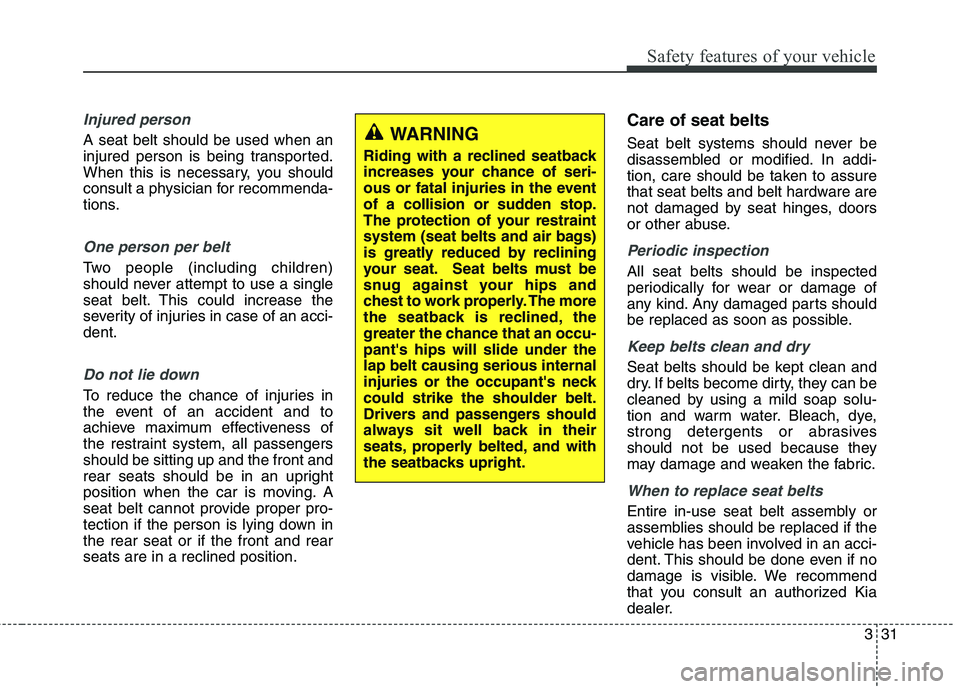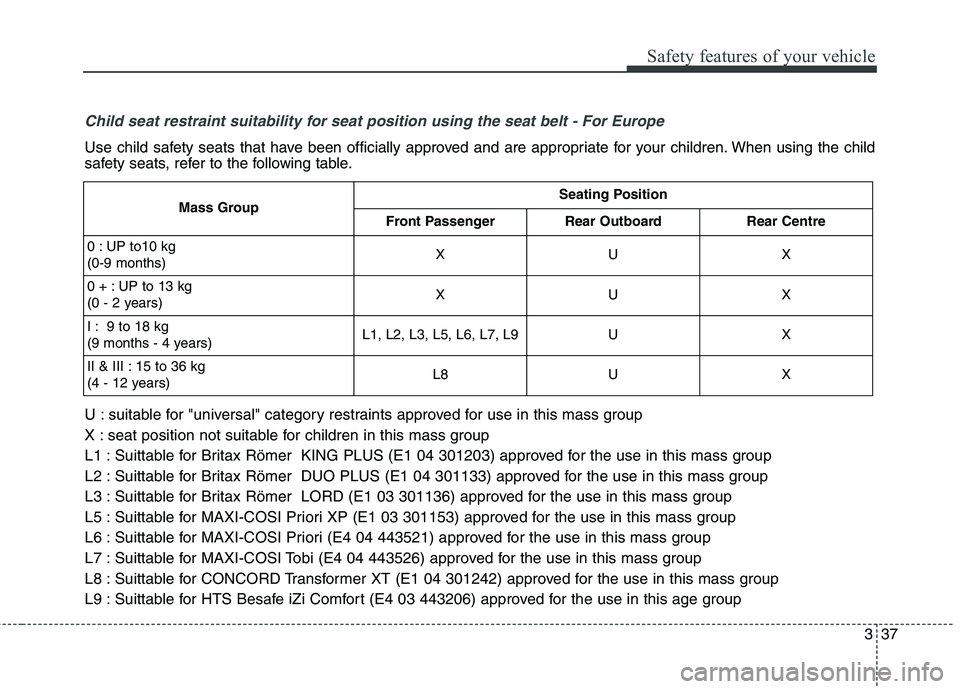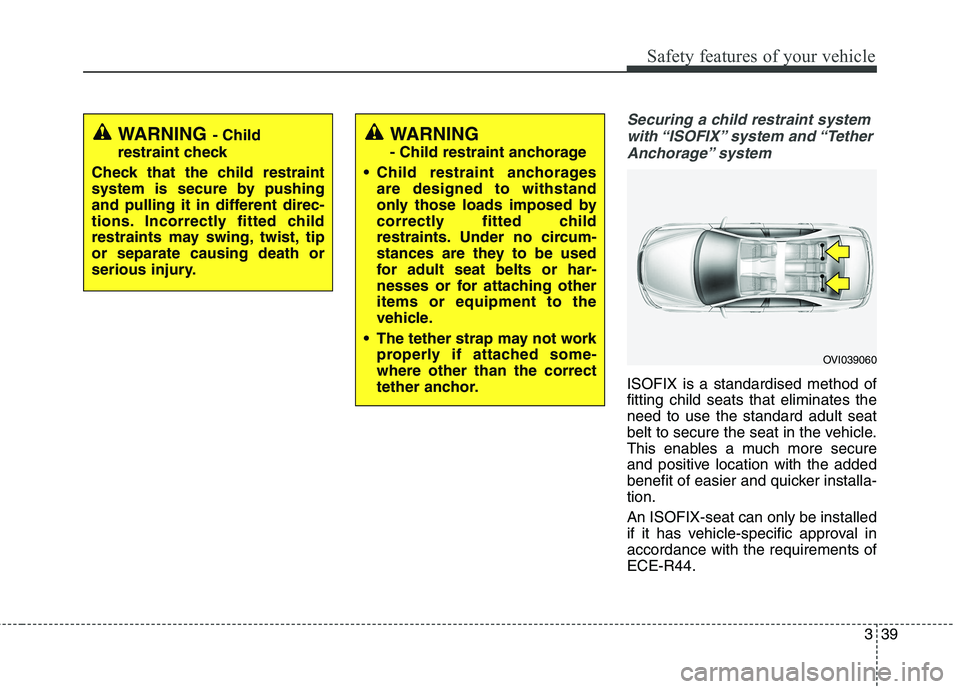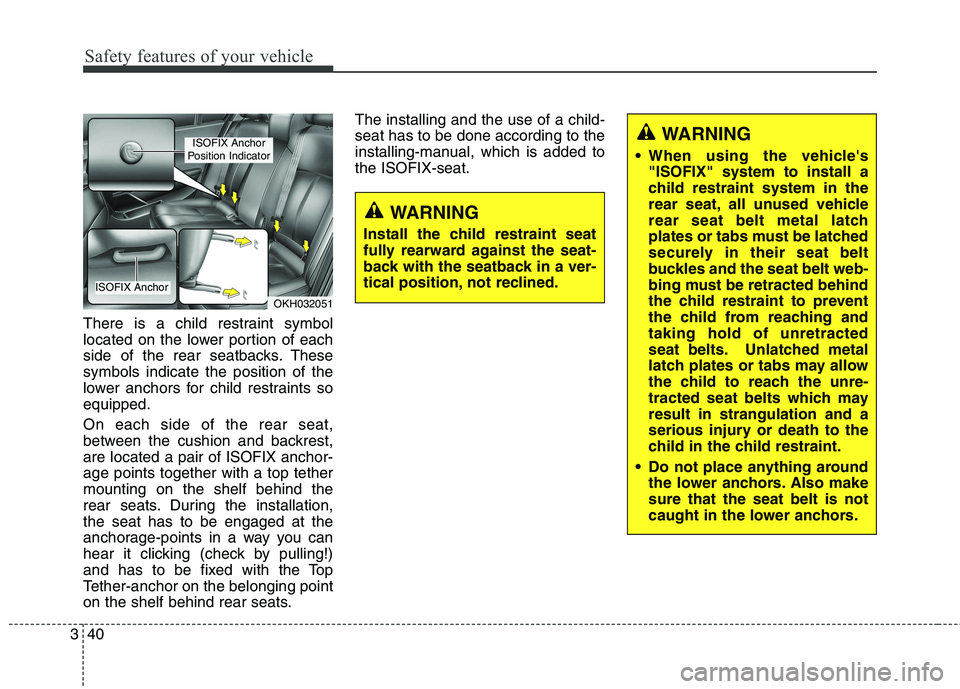2013 KIA QUORIS belt
[x] Cancel search: beltPage 46 of 485

331
Safety features of your vehicle
Injured person
A seat belt should be used when an
injured person is being transported.
When this is necessary, you should
consult a physician for recommenda-
tions.
One person per belt
Two people (including children)
should never attempt to use a single
seat belt. This could increase the
severity of injuries in case of an acci-dent.
Do not lie down
To reduce the chance of injuries in
the event of an accident and to
achieve maximum effectiveness of
the restraint system, all passengersshould be sitting up and the front and
rear seats should be in an upright
position when the car is moving. A
seat belt cannot provide proper pro-
tection if the person is lying down inthe rear seat or if the front and rearseats are in a reclined position.Care of seat belts
Seat belt systems should never be
disassembled or modified. In addi-
tion, care should be taken to assure
that seat belts and belt hardware are
not damaged by seat hinges, doors
or other abuse.
Periodic inspection
All seat belts should be inspected
periodically for wear or damage of
any kind. Any damaged parts should
be replaced as soon as possible.
Keep belts clean and dry
Seat belts should be kept clean and
dry. If belts become dirty, they can be
cleaned by using a mild soap solu-
tion and warm water. Bleach, dye,
strong detergents or abrasives
should not be used because they
may damage and weaken the fabric.
When to replace seat belts
Entire in-use seat belt assembly or
assemblies should be replaced if the
vehicle has been involved in an acci-
dent. This should be done even if no
damage is visible. We recommend
that you consult an authorized Kia
dealer.
WARNING
Riding with a reclined seatback
increases your chance of seri-
ous or fatal injuries in the event
of a collision or sudden stop.
The protection of your restraint
system (seat belts and air bags)
is greatly reduced by reclining
your seat. Seat belts must be
snug against your hips and
chest to work properly. The more
the seatback is reclined, the
greater the chance that an occu-pant's hips will slide under thelap belt causing serious internal
injuries or the occupant's neckcould strike the shoulder belt.
Drivers and passengers should
always sit well back in their
seats, properly belted, and with
the seatbacks upright.
Page 47 of 485

Safety features of your vehicle
32
3
CHILD RESTRAINT SYSTEM
Children riding in the car should sit in
the rear seat and must always be
properly restrained to minimize the
risk of injury in an accident, sudden
stop or sudden maneuver. According
to accident statistics, children are
safer when properly restrained in therear seats than in the front seat.
Larger children not in a child restraintshould use one of the seat belts pro-vided.
You should be aware of the specific
requirements in your country. Child
and/or infant safety seats must be
properly placed and installed in the
rear seat. You must use a commer-
cially available child restraint systemthat meets the requirements of the
Safety Standards of your country.
Child restraint systems are designed
to be secured in vehicle seats by lap
belts or the lap belt portion of a
lap/shoulder belt, or by a tether
anchor and/or ISOFIX anchors. Children could be injured or killed in
a crash if their restraints are not
properly secured. For small children
and babies, a child seat or infant seat
must be used. Before buying a par-
ticular child restraint system, make
sure it fits your car seat and seat
belts, and fits your child. Follow all
the instructions provided by the man-
ufacturer when installing the child
restraint system.
WARNING
A child restraint system must be placed in the rear seat.
Never install a child or infant
seat on the front passenger's
seat. Should an accidentoccur and cause the passen-
ger-side air bag to deploy, it
could severely injure or kill an
infant or child seated in an
infant or child seat. Thus only
use a child restraint in the
rear seat of your vehicle.
(Continued)
(Continued)
A seat belt or child restraintsystem can become very hot
if it is left in a closed vehicle
on a sunny day, even if theoutside temperature does not
feel hot. Be sure to check the
seat cover and buckles before
placing a child there.
When the child restraint sys- tem is not in use, store it in
the luggage area or fasten itwith a seat belt so that it will
not be thrown forward in the
case of a sudden stop or anaccident.
Children may be seriously injured or killed by an inflating
air bag. All children, even
those too large for child
restraints, must ride in therear seat.
Page 48 of 485

333
Safety features of your vehicle
WARNING
To reduce the chance of serious or fatal injuries:
Children of all ages are safer when restrained in the rear
seat. A child riding in the
front passenger seat can be
forcefully struck by an inflat-
ing air bag resulting in seri-ous or fatal injuries.
Always follow the child restraint system manufactur-
er’s instructions for installa-
tion and use of the childrestraint.
Always make sure the child seat is secured properly in the
vehicle and your child is
securely restrained in the
child seat.
Never hold a child in your arms or lap when riding in a
vehicle. The violent forces cre-ated during a crash will tear
the child from your arms and
throw the child against the
vehicle’s interior.
(Continued)(Continued)
Never put a seat belt overyourself and a child. During a
crash, the belt could press
deep into the child causingserious internal injuries.
Never leave children unat- tended in a vehicle – not even
for a short time. The car can
heat up very quickly, resulting
in serious injuries to children
inside. Even very young chil-
dren may inadvertently cause
the vehicle to move, entangle
themselves in the windows, or
lock themselves or others
inside the vehicle.
Never allow two children, or any two persons, to use thesame seat belt.
Children often squirm and reposition themselves improp-
erly. Never let a child ride withthe shoulder belt under their
arm or behind their back.
Always properly position and
secure children in the rear seat.
(Continued)(Continued)
Never allow a child to stand-up or kneel on the seat or floor
of a moving vehicle. During a
collision or sudden stop, the
child can be violently thrown
against the vehicle’s interior,
resulting in serious injury.
Never use an infant carrier or a child safety seat that "hooks"
over a seatback, it may not
provide adequate security inan accident.
Seat belts can become very hot, especially when the vehi-
cle is parked in direct sunlight.
Always check seat belt buck-
les before fastening them over
a child.
After an accident, we recom- mend that the system be
checked by an authorized Kia
dealer.
If there is not enough space to place the child restraint sys-tem because of the driver's
seat, install the child restraintsystem in the rear right seat.
Page 50 of 485

335
Safety features of your vehicle
Installing a child restraint systemby lap belt (on the center rear seat) (if equipped)
To install a child restraint system on
the center rear seats, do the follow-ing:
1. Place the child restraint system on the center rear seat.
2. Extend the latch plate tongue of the lap belt.
3. Route the lap belt through the restraint according to the seat
manufacturer’s instructions. 4. Buckle the seat belt and adjust the
lap belt for a snug hold on the child
restraint by pulling on the loose
end of the belt. After installation of
the child restraint system, try to
move it in all directions to be sure
the child restraint system issecurely installed.
1GHA2260/H
WARNING - Child seat installation
A child can be seriously injured or killed in a collision
if the child restraint is not
properly anchored to the vehi-
cle and the child is not prop-
erly restrained in the child
restraint. Before installing the
child restraint system, read
the instructions supplied by
the child restraint system
manufacturer.
If the seat belt does not oper- ate as described in this sec-
tion, we recommend that the
system be checked by an
authorized Kia dealer.
Failure to observe this manu- al's instructions regarding
child restraint systems and
the instructions provided with
the child restraint system
could increase the chance
and/or severity of injury in anaccident.
Page 51 of 485

Safety features of your vehicle
36
3
Installing a child restraint system
by lap/shoulder belt
To install a child restraint system on
the outboard or center rear seats, do
the following:
1. Place the child restraint system in the seat and route the lap/shoul- der belt around or through the
restraint, following the restraint
manufacturer’s instructions. Be
sure the seat belt webbing is nottwisted. 2. Fasten the lap/shoulder belt latch
into the buckle. Listen for the dis-
tinct “click” sound.Position the release button so that it
is easy to access in case of an emer-gency.
3. Buckle the seat belt and allow the seat belt to take up any slack. After
installation of the child restraint
system, try to move it in all direc-
tions to be sure the child restraintsystem is securely installed.
If you need to tighten the belt, pull
more webbing toward the retractor.
When you unbuckle the seat belt and
allow it to retract, the retractor will
automatically revert back to its nor-mal seated passenger emergency
locking usage condition.
OEN036101
E2MS103005
OEN036104
Page 52 of 485

337
Safety features of your vehicle
Child seat restraint suitability for seat position using the seat belt - For Europe
Use child safety seats that have been officially approved and are appropriate for your children. When using the child
safety seats, refer to the following table.
U : suitable for "universal" category restraints approved for use in this mass group
X : seat position not suitable for children in this mass group
L1 : Suittable for Britax Römer KING PLUS (E1 04 301203) approved for the use in this mass group
L2 : Suittable for Britax Römer DUO PLUS (E1 04 301133) approved for the use in this mass group
L3 : Suittable for Britax Römer LORD (E1 03 301136) approved for the use in this mass group
L5 : Suittable for MAXI-COSI Priori XP (E1 03 301153) approved for the use in this mass group
L6 : Suittable for MAXI-COSI Priori (E4 04 443521) approved for the use in this mass group
L7 : Suittable for MAXI-COSI Tobi (E4 04 443526) approved for the use in this mass group
L8 : Suittable for CONCORD Transformer XT (E1 04 301242) approved for the use in this mass group
L9 : Suittable for HTS Besafe iZi Comfort (E4 03 443206) approved for the use in this age group
Mass GroupSeating Position
Front PassengerRear OutboardRear Centre
0 : UP to10 kg (0-9 months)XUX
0 + : UP to 13 kg
(0 - 2 years)XUX
I : 9 to 18 kg
(9 months - 4 years)L1, L2, L3, L5, L6, L7, L9UX
II & III : 15 to 36 kg
(4 - 12 years)L8UX
Page 54 of 485

339
Safety features of your vehicle
Securing a child restraint systemwith “ISOFIX” system and “Tether Anchorage” system
ISOFIX is a standardised method of fitting child seats that eliminates theneed to use the standard adult seat
belt to secure the seat in the vehicle.
This enables a much more secure
and positive location with the added
benefit of easier and quicker installa-tion. An ISOFIX-seat can only be installed
if it has vehicle-specific approval inaccordance with the requirements ofECE-R44.
WARNING - Child
restraint check
Check that the child restraint
system is secure by pushing
and pulling it in different direc-
tions. Incorrectly fitted child
restraints may swing, twist, tipor separate causing death or
serious injury.WARNING
- Child restraint anchorage
Child restraint anchorages are designed to withstand
only those loads imposed by
correctly fitted child
restraints. Under no circum-
stances are they to be used
for adult seat belts or har-
nesses or for attaching otheritems or equipment to the
vehicle.
The tether strap may not work properly if attached some-where other than the correct
tether anchor.
OVI039060
Page 55 of 485

Safety features of your vehicle
40
3
There is a child restraint symbol
located on the lower portion of each
side of the rear seatbacks. Thesesymbols indicate the position of the
lower anchors for child restraints soequipped. On each side of the rear seat,
between the cushion and backrest,are located a pair of ISOFIX anchor-age points together with a top tethermounting on the shelf behind the
rear seats. During the installation,the seat has to be engaged at the
anchorage-points in a way you can
hear it clicking (check by pulling!)
and has to be fixed with the Top
Tether-anchor on the belonging point
on the shelf behind rear seats. The installing and the use of a child-seat has to be done according to the
installing-manual, which is added tothe ISOFIX-seat.
WARNING
Install the child restraint seat
fully rearward against the seat-
back with the seatback in a ver-
tical position, not reclined.
WARNING
When using the vehicle's "ISOFIX" system to install a
child restraint system in the
rear seat, all unused vehicle
rear seat belt metal latch
plates or tabs must be latched
securely in their seat belt
buckles and the seat belt web-
bing must be retracted behind
the child restraint to prevent
the child from reaching andtaking hold of unretracted
seat belts. Unlatched metal
latch plates or tabs may allow
the child to reach the unre-
tracted seat belts which mayresult in strangulation and a
serious injury or death to the
child in the child restraint.
Do not place anything around the lower anchors. Also makesure that the seat belt is not
caught in the lower anchors.
OKH032051
ISOFIX Anchor
Position Indicator
ISOFIX Anchor